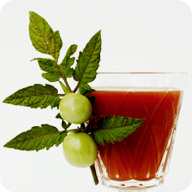SOURCE: Dr. Mercola website
Reasons to Juice
There are three main reasons why you will want to consider incorporating vegetable juicing into your optimal health program:
- Juicing helps you absorb all the nutrients from the vegetables. This is important because most of us have impaired digestion as a result of making less-than-optimal food choices over many years. This limits your body’s ability to absorb all the nutrients from the vegetables. Juicing will help to “pre-digest” them for you, so you will receive most of the nutrition, rather than having it go down the toilet.
- Juicing allows you to consume an optimal amount of vegetables in an efficient manner. If you are a carb type, you should eat one pound of raw vegetables per 50 pounds of body weight per day. Some people may find eating that many vegetables difficult, but it can be easily accomplished with a quick glass of vegetable juice.
- You can add a wider variety of vegetables in your diet. Many people eat the same vegetable salads every day. This violates the principle of regular food rotation and increases your chance of developing an allergy to a certain food. But with juicing, you can juice a wide variety of vegetables that you may not normally enjoy eating whole.
Please note that the order listed below is only intended for those that are new to juicing so you do have a pleasant experience with it. However, if you use ¼ to ½ lemon or lime to the juice lemon and lime effectively counter their bitterness.
Please note it would be FAR better to use lemon or limes than carrots, beets or apples, which have far more fructose than lemons or limes.
Step 1: If you are new to juicing. I recommend starting out with these vegetables, as they are the easiest to digest and tolerate:
- Celery
- Fennel (anise)
- Cucumbers
These three aren’t as nutrient dense as the dark green vegetables. Once you get used to the 3 vegetables listed above, you can start adding the more nutritionally valuable, but less palatable, vegetables into your juice.
Step 2: When you’ve acclimatized yourself to juicing, you can start adding these vegetables:
- Red leaf lettuce
- Green Leaf lettuce
- Romaine lettuce
- Endive
- Escarole
- Spinach
Step 3: After you’re used to these, then go to the next step:
- Cabbage
- Chinese Cabbage
- Bok Choy
An interesting side note: Cabbage juice is one of the most healing nutrients for ulcer repair as it is a huge source of vitamin U.
Step 4: When you’re ready, move on to adding herbs to your juicing. Herbs also make wonderful combinations, and here are two that work exceptionally well:
- Parsley
- Cilantro
You need to be cautious with cilantro, as many cannot tolerate it well. If you are new to juicing, hold off on the cilantro. These are more challenging to consume, but they are highly beneficial.
Step 5: The last step: Only use one or two of these leaves, as they are very bitter:
- Kale
- Collard Greens
- Dandelion Greens
- Mustard Greens (bitter)
When purchasing collard greens, find a store that sells the leaves still attached to the main stalk. If they are cut off, the vegetable rapidly loses many of its valuable nutrients.
Lesson 3: Make your juice taste great.
If you would like to make your juice taste a bit more palatable, especially in the beginning, you can add these elements:
- Lemons and Limes: You can also add a quarter to half a lemon a lime (leaving much of the white rind on).
- Cranberries: You can also add some cranberries if you enjoy them. Researchers have discovered that cranberries have five times the antioxidant content of broccoli, which means they may protect against cancer, stroke and heart disease. In addition, they are chock-full of phytonutrients, and can help women avoid urinary tract infections. Limit the cranberries to about 4 ounces per pint of juice.
- Fresh ginger: This is an excellent addition if you can tolerate it. It gives your juice a little “kick”! And, as an added boon, researchers have found that ginger can have dramatic effects on cardiovascular health, including preventing atherosclerosis, lowering cholesterol levels, and preventing the oxidation of low density lipoprotein (LDL).
SOURCE: Dr. Mercola website

